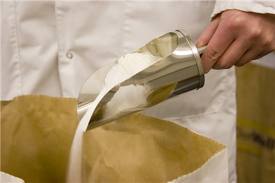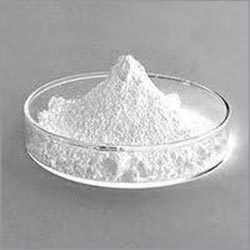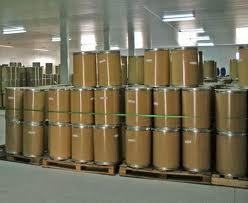Miconazole Nitrate
1700.0 INR/Kilograms
Product Details:
- Molecular Weight 416.1 Grams (g)
- Storage Other
- Structural Formula C18H15Cl4N3O4
- EINECS No 245-256-6
- Solubility slightly soluble in water
- Smell No Smell
- Boiling point 555.1 C
- Click to View more
X
Miconazole Nitrate Price And Quantity
- 1700.00 - 1800.00 INR/Kilograms
- 25 Kilograms
- 1700.0 INR/Kilograms
Miconazole Nitrate Product Specifications
- 29332990
- C18H15Cl4N3O4
- Miconazole is an antifungal medication used to treat ring worm, pityriasis versicolor, and yeast infections of the skin or vagina. It is used for ring worm of the body, groin, and feet. It is applied to the skin or vagina as a cream or ointment.
- Odorless
- miconazole
- Not applicable
- 98%
- below 30 m
- white crystalline powder
- 22916-47-8
- Medicine Grade
- Miconazole Nitrate
- NMT 0.5 %
- 170.5 C
- 555.1 C
- No Smell
- Pharmaceutical Intermediates
- 5 Years
- not applicable
- Powder
- Other
- 416.1 Grams (g)
- slightly soluble in water
- 245-256-6
- C18H15Cl4N3O4
Miconazole Nitrate Trade Information
- INDIA
- Cash Advance (CA) Cash in Advance (CID) Days after Acceptance (DA) Delivery Point (DP) Letter of Credit at Sight (Sight L/C) Telegraphic Transfer (T/T) Letter of Credit (L/C)
- 100 Kilograms Per Day
- 7 Days
- Yes
- Free samples are available
- drum packing
- Australia Central America Asia North America South America Eastern Europe Western Europe Middle East Africa
- All India
- GMP / ISO
Product Description
Miconazole nitrate properties
- CAS No.: 22832-87-7
- Formula: C18H15Cl4N3O4
- Molecular Weight: 479.16
- Deleted CAS: 75319-48-1
- Synonyms: 1-[2-(2,4-dichlorophenyl)-2-[(2,4-dichlorophenyl)methoxy]ethyl]imidazole; nitric acid;Conofite;1H-Imidazole,1-[2-(2,4-dichlorophenyl)-2- [(2,4-dichlorophenyl)methoxy]ethyl]-,mononitrate;Gyno-Monistat;Micatin;Imidazole, mononitrate;Florid;1H-Imidazole, 1-[2- (2,4-dichlorophenyl)-2-[(2, 4-dichlorophenyl)methoxy]ethyl]-, mononitrate;Daktarin;Aflorix;Miconazol Nitrate;
- EINECS: 245-256-6
- Density: 1.451g/cm3
- Melting Point: 170-185 ÂC
- Boiling Point: 555.1 ÂC at 760 mmHg
- Flash Point: 289.5 ÂC
- Appearance: White crystal powder
Introduction of product:
Miconazole, like other antifungal medications, is used in treating ringworm, pityriasis versicolor, and yeast infections of the skin. You can use it to treat ringworm of your feet, legs, and groin. This is applied as a cream or ointment on the skin. As an azole antifungal with broad spectrum activity, miconazole treats fungal infections of the mouth, skin and skin including candidiasis.
How does it work:
Children and adults 12 years old and older use miconazole for the treatment of yeast infections. It is one of a class of drugs called imidazoles that have antifungal properties. Infections are prevented by stopping the growth of fungi. With this condition, miconazole treatments reduce pain, itching, and discharge. It stops the growth of yeast (fungus) that causes the infection. It comes in cream as well as tablet forms.
Manufacturing process:
The steps in the production process include:
2,4-dichlorobenzyl and imidazole are the raw materials utilized in the production process. A reaction is performed at the temperature 10-100 degrees Celsius and reaction liquid is allowed to cool down at the room temperature after that.
Dosage of usage:
Patients with tinea pedis, tinea cruris, tinea corporis, and cutaneous candidiasis should apply enough miconazole Cream twice daily (morning and evening), and patients with tinea versicolor should apply it once daily. Those using Cream in intertriginous areas should apply the product sparingly and smooth it in well to avoid maceration.
Side effects:
The treated skin may become red, irritated, swollen, stinging, aggravated, irritated, or even flake. Do not wait to notify your doctor or pharmacist if these side effects persist or worsen. Allergic reactions to this drug are rare. Be prepared to seek immediate medical attention if you experience any of the following symptoms: severe dizziness, breathing difficulties, rash and itching/swelling.
Tell us about your requirement

Price:
Quantity
Select Unit
- 50
- 100
- 200
- 250
- 500
- 1000+
Additional detail
+91
Email









 : nilesh.sheth70
: nilesh.sheth70
